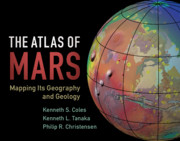Book contents
- The Atlas of Mars
- Additional material
- The Atlas of Mars
- Copyright page
- Table of Contents
- Preface
- Acknowledgments
- Abbreviations
- How to Use this Atlas
- Sources of Images
- Chapter 1 Introduction
- Chapter 2 History of Exploration of Mars
- Chapter 3 Global Character of Mars
- Chapter 4 Regional Geographic Features and Surface Views of Mars
- Chapter 5 Geology of Mars
- Map Sheets
- Mare Boreum (MC-1)
- Diacria (MC-2)
- Arcadia (MC-3)
- Mare Acidalium (MC-4)
- Ismenius Lacus (MC-5)
- Casius (MC-6)
- Cebrenia (MC-7)
- Amazonis (MC-8)
- Tharsis (MC-9)
- Lunae Palus (MC-10)
- Oxia Palus (MC-11)
- Arabia (MC-12)
- Syrtis Major (MC-13)
- Amenthes (MC-14)
- Elysium (MC-15)
- Memnonia (MC-16)
- Phoenicis Lacus (MC-17)
- Coprates (MC-18)
- Margaritifer Sinus (MC-19)
- Sinus Sabaeus (MC-20)
- Iapygia (MC-21)
- Mare Tyrrhenum (MC-22)
- Aeolis (MC-23)
- Phaethontis (MC-24)
- Thaumasia (MC-25)
- Argyre (MC-26)
- Noachis (MC-27)
- Hellas (MC-28)
- Eridania (MC-29)
- Mare Australe (MC-30)
- Moons: Phobos and Deimos
- Appendix
- Gazetteer
- References
- Index
Syrtis Major (MC-13)
from Map Sheets
Published online by Cambridge University Press: 16 August 2019
- The Atlas of Mars
- Additional material
- The Atlas of Mars
- Copyright page
- Table of Contents
- Preface
- Acknowledgments
- Abbreviations
- How to Use this Atlas
- Sources of Images
- Chapter 1 Introduction
- Chapter 2 History of Exploration of Mars
- Chapter 3 Global Character of Mars
- Chapter 4 Regional Geographic Features and Surface Views of Mars
- Chapter 5 Geology of Mars
- Map Sheets
- Mare Boreum (MC-1)
- Diacria (MC-2)
- Arcadia (MC-3)
- Mare Acidalium (MC-4)
- Ismenius Lacus (MC-5)
- Casius (MC-6)
- Cebrenia (MC-7)
- Amazonis (MC-8)
- Tharsis (MC-9)
- Lunae Palus (MC-10)
- Oxia Palus (MC-11)
- Arabia (MC-12)
- Syrtis Major (MC-13)
- Amenthes (MC-14)
- Elysium (MC-15)
- Memnonia (MC-16)
- Phoenicis Lacus (MC-17)
- Coprates (MC-18)
- Margaritifer Sinus (MC-19)
- Sinus Sabaeus (MC-20)
- Iapygia (MC-21)
- Mare Tyrrhenum (MC-22)
- Aeolis (MC-23)
- Phaethontis (MC-24)
- Thaumasia (MC-25)
- Argyre (MC-26)
- Noachis (MC-27)
- Hellas (MC-28)
- Eridania (MC-29)
- Mare Australe (MC-30)
- Moons: Phobos and Deimos
- Appendix
- Gazetteer
- References
- Index
Summary
The Syrtis Major quadrangle is named after a prominent dark feature, discovered by Christiaan Huygens, in 1659, as the first surface feature recognized on another planet (Figure 13.A). The name “Syrtis Major,” however, originated more than 200 years later, with the astronomer Giovanni Schiaparelli. The quadrangle contains the volcanic province, defined by Syrtis Major Planum, a large but gently sloping dome that rises to almost 2,100 m in elevation. Centered on Syrtis Major Planum are two rimless depressions named Nili and Meroe Paterae. West of Syrtis Major Planum lie the ancient cratered highlands of Mars, named Terra Sabaea. This ancient terrain descends to near datum and is pockmarked with multiple ancient impact craters and basins, including Antoniadi (400 km in diameter), Baldet (181 km in diameter), and Flammarion (174 km in diameter). Isidis Planitia resides to the east of Syrtis Major Planum, and represents the smooth, infilled surface of a very ancient multi-ring impact basin that was at least 1,500 km in original diameter. The floor of Isidis Planitia is close to 4 km below datum. Large-scale landforms, characteristic of giant impact basins, are circumferential to Isidis Planitia. To the south, Libya Montes forms an arcuate ring of large, angular mountains, some of which rise >2 km above the surrounding plains. Northwestern Isidis Planitia is bounded by the elongate and arcuate troughs of Nili Fossae, which are up to 40 km wide and 1,300 m deep. Arena Colles forms the best-preserved highland–lowland transition zone within the Syrtis Major quadrangle, and it is composed of a field of rugged knobs as well as their intervening plains.
Information
- Type
- Chapter
- Information
- The Atlas of MarsMapping its Geography and Geology, pp. 136 - 139Publisher: Cambridge University PressPrint publication year: 2019
